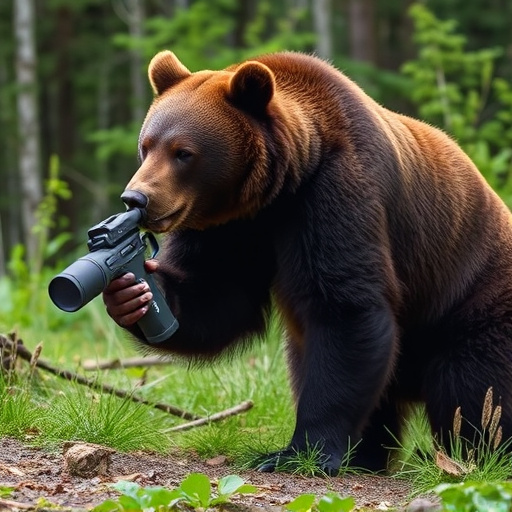Bear spray, an effective deterrent against aggressive bears, is composed of capsaicin from chili peppers. Its success depends on factors like wind, distance, and bear behavior, with a maximum potency range of 20-30 feet (6-9 meters). Research highlights the importance of proper usage techniques, such as aiming low, alongside other safety measures like noise-making and attack response knowledge for optimal protection in bear country. While powerful, no single method is 100% guaranteed, emphasizing the need for a comprehensive safety strategy. (How Effective Is Bear Spray Research?)
“In regions teeming with wilderness, encounters with bears can range from awe-inspiring to life-threatening. Enter bear defense spray—a popular tool for outdoor enthusiasts aiming to deter and escape such confrontations. This article delves into the effectiveness of bear spray, exploring its mechanism, real-world performance, and safe usage practices. With a focus on ‘How Effective Is Bear Spray?’ we examine research and factors influencing its success, empowering adventurers with knowledge crucial for navigating potential bear encounters.”
- Understanding Bear Spray: Mechanism and Effectiveness
- Factors Affecting Bear Spray Performance in Real-World Scenarios
- Best Practices for Using and Carrying Bear Spray Safely
Understanding Bear Spray: Mechanism and Effectiveness
Bear spray, also known as defense spray, is a popular tool for hikers, campers, and wilderness enthusiasts to protect themselves against aggressive bears. Understanding how it works is crucial when considering its effectiveness as a safety measure. The active ingredient in bear spray is typically capsaicin, derived from chili peppers. When sprayed towards an attacking bear, capsaicin irritates the animal’s eyes, nose, and respiratory system, temporarily disorienting and deterring it.
Research on bear spray’s effectiveness has yielded mixed results. Studies show that when used correctly, bear spray can significantly reduce the risk of bear attacks. It is most effective at close range, with a spray pattern that covers the bear’s face and eyes. However, factors like wind direction, distance, and the bear’s behavior can impact its success. Some bears may even become desensitized to capsaicin over time, rendering the spray less effective in repeated encounters. Thus, while bear spray is a valuable tool, it should be used as part of a comprehensive safety strategy in bear country.
Factors Affecting Bear Spray Performance in Real-World Scenarios
When it comes to assessing bear spray effectiveness, several factors come into play in real-world scenarios. One of the key considerations is the distance at which the spray is deployed. Research indicates that bear spray can be highly effective up to a certain range, typically around 20 to 30 feet (6 to 9 meters). Beyond this distance, the spray’s concentration diminishes, reducing its potential impact on deterring an aggressive bear.
Another crucial aspect is the environmental conditions. Factors like wind speed and direction can significantly influence the spray’s reach and effectiveness. A strong headwind might carry the spray away from the bear, while a tailwind could potentially blow it back towards the user. Additionally, weather conditions such as temperature and humidity can affect the spraying mechanism and the spray’s overall performance. Therefore, understanding these variables is essential in How Effective Is Bear Spray Research to ensure optimal protection during a potential wilderness encounter.
Best Practices for Using and Carrying Bear Spray Safely
When it comes to best practices for using and carrying bear spray, safety is paramount. Always keep the can in a secure, easily accessible location—preferably on your waist or in a holster—to ensure quick deployment during an encounter. Prior to venturing into known bear country, familiarize yourself with the proper usage technique; practice makes perfect. Aiming low and spraying towards the base of a bear’s legs is key, as it can effectively deter an attack without risking harm to humans or the animal.
Research plays a crucial role in understanding how effective bear spray truly is. Studies have shown that when used correctly, bear spray can significantly reduce the risk of injury during encounters with grizzly and black bears. However, keep in mind that no single defense mechanism is foolproof; carrying bear spray should complement other safety precautions like making noise while hiking, avoiding known bear habitats, and knowing how to respond during an attack.
Bear spray has proven to be an important tool in defending against wildlife encounters, particularly with grizzly bears. Extensive research has shown its effectiveness when used correctly, but real-world performance can vary due to several factors. Understanding the mechanism of bear spray and following best practices for use and carrying can significantly enhance safety during potential bear meetings. While no single solution guarantees protection, staying informed about the latest research and being prepared are crucial steps in navigating the wilderness responsibly.
